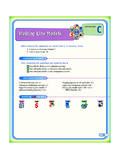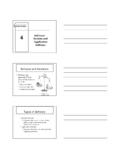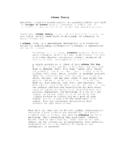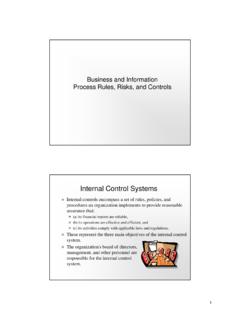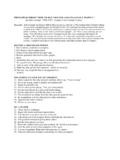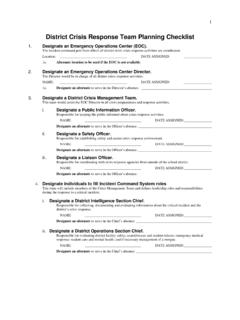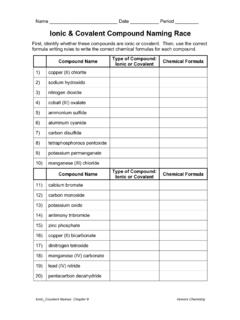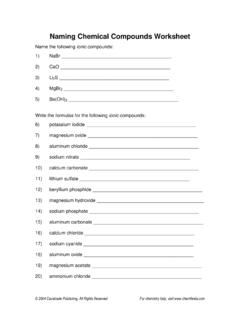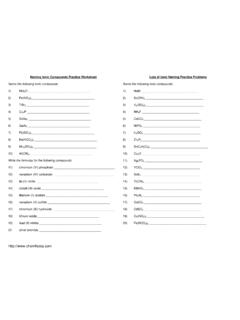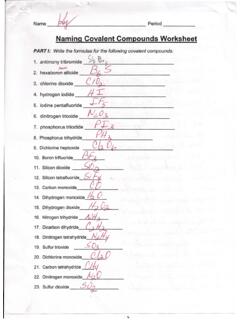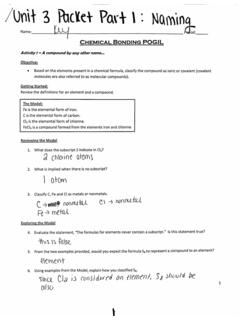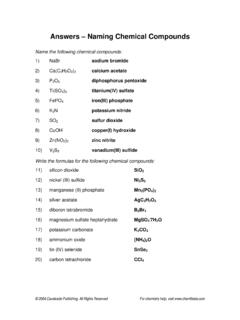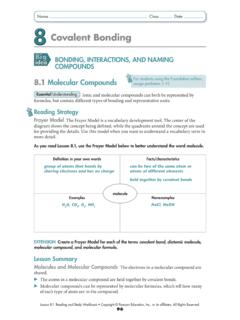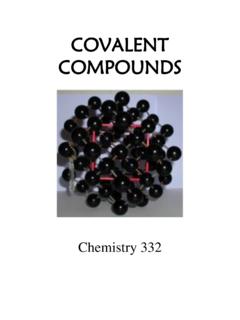Transcription of CSUS Chemistry 1A Nomenclature Worksheet Dr. Mack
1 CSUS Chemistry 1A Nomenclature Worksheet Dr. Mack Page 1 of 9 Nomenclature Worksheet Instructions: In order to succeed in chem. 1A, you will be required the learn and apply the principles of chemical Nomenclature . Data shows that students that fail to master Nomenclature by the 3rd week, general do not pass the course. Introduction: Every discipline or field of study has its own terminology. The vocabulary of Chemistry uses words that you may or may not have heard before such as electrolysis, effusion, hybridization, resonance, and stoichiometry. Chemists also use words that have a different meaning than the common definition, such as the words mole or degenerate.
2 As you study your text in preparation for lecture, it is important that you take the time to learn the new words and terms you encounter. You will find that each chapter of your text summarizes the Key Terms introduced in a section prior to the exercises and problems. Your text also contains a glossary located in appendix G at its end. As a student in Chem. 1A, you must learn chemical Nomenclature in order to understand your texts and lectures. Learning the vocabulary of Chemistry prior to lecture allows you to better comprehend the material covered. This means you ll get more out of your lectures and lab discussions, which in turn will likely increase your performance on exams and quizzes.
3 Performance on quizzes and exams requires that you communicate using proper terms and symbols that are specific to Chemistry . One most certainly would not attempt a course like German or French with out learning the language and so it is the case with Chemistry . It is imperative that you have a solid grasp of the language of Chemistry , as it is critical to your success in this course. Mastery of the vocabulary of Chemistry can t be put off. The more you procrastinate, the further you ll get behind and the lower your grade will become. The communication of the make up of matter in Chemistry follows a set of conventions or rules that we call Nomenclature . Through Nomenclature , one can define the elemental composition and relative proportions of elements in a substance.
4 This has grave importance, as there are multitudes of chemical combinations. How do you learn chemical Nomenclature ? You practice and practice and practice. Some of you may find that flash cards will help. Others may feel that exercises like this are sufficient. Regardless of your preference of learning Nomenclature , you must work hard to incorporate it into your working knowledge. The following pages contain notes that have been prepared as an aid in your preparation for the Nomenclature workshop in lab. Please read these over carefully prior to the laboratory. You will also need to consult your text (sections ) for additional help and reference. You may also consult the CD that accompanies your text.
5 Don t forget the library is full of general Chemistry texts and study guides. FAILURE TO LEARN CHEMICAL Nomenclature WILL GRAVELY IMPACT YOUR PERFORMANCE IN THIS COURSE. I. IONIC COMPOUNDS Main Group Metals (Groups IA, IIA, and IIIA) These metals tend to form cations by losing all of their outermost (valence) electrons. The charge on the cation is the same as the group number. The cation is given the same name as the neutral metal atom. Group Element Cation Ion name Group Element Cation Ion name IA H H+ hydrogen ion IIA Mg Mg2+ magnesium ion Li Li+ lithium ion Ca Ca2+ calcium ion Na Na+ sodium ion Sr Sr2+ strontium ion K K+ potassium ion Ba Ba2+ barium ion Cs Cs+ cesium ion IIIA Al Al3+ aluminum ion CSUS Chemistry 1A Nomenclature Worksheet Dr.
6 Mack Page 2 of 9 Transition (B group) and Post Transition (Group IVA and VA) Metals The charges of the transition metals must be memorized (in chem. 1B you will learn why the charges are ). Many of these ions have common or older names ( ic endings go with the higher charge, ous endings go with the lower charge). The systematic names (also known as the Stock system)1 for these ions are derived by naming the metal first, followed in parentheses by the charge written in Roman numerals. Metal Ion Systematic name Common name Cadmium Cd2+ cadmium ion Chromium Cr2+ chromium (II) ion chromous ion Cr3+ chromium (III) ion chromic ion Cobalt Co2+ cobalt (II) ion cobaltous ion Co3+ cobalt (III) ion cobaltic ion Copper Cu+ copper (I) ion cuprous ion Cu2+ copper (II) ion cupric ion Gold Au3+ gold (III) ion Iron Fe2+ iron (II) ion ferrous ion Fe3+ iron (III) ion ferric ion Manganese Mn2+ manganese (II) ion manganous ion Mn3+ manganese (III) ion manganic ion Mercury2 Hg22+ mercury (I) ion mercurous ion Hg2+ mercury (II) ion mercuric ion Nickel Ni2+ nickel (II)
7 Ion Silver Ag+ silver ion Zinc Zn2+ zinc ion Tin Sn2+ tin (II) ion stannous ion Sn4+ tin (IV) ion stannic ion Lead Pb2+ lead (II) ion plumbous ion Pb4+ lead (IV) ion plumbic ion Bismuth Bi3+ bismuth (III) ion Bi5+ bismuth (V) ion Anions Main Group Nonmetals (Groups IVA, VA, VIA, and VIIA): The nonmetal elements tend to form anions by gaining enough electrons to fill their valence shell with eight electrons. The anion is named by taking the element stem name and adding the ending ide. Group Element Anion Ion name Group Element Anion Ion name IVA C C4 carbide ion VIA Se Se2 selenide ion Si Si4 silicide ion Te Te2 telluride ion VA N N3 nitride ion VIIA F F fluoride ion P P3 phosphide ion Cl Cl chloride ion As As3 arsenide ion Br Br bromide ion VIA O O2 oxide ion I I iodide ion 1 In this course, all exams and quizzes will use the stock form for Nomenclature ; you will however see examples of the common names in your text and the homework.
8 2 The mercury (I) cation is a special case; it consists of two Hg+ ions joined together, and so is always found as Hg22+. CSUS Chemistry 1A Nomenclature Worksheet Dr. Mack Page 3 of 9 S S2 sulfide ion IA H H hydride ion Polyatomic Ions Polyatomic ions are ions that are composed of two or more atoms that are linked by covalent bonds, but that still have a net deficiency or surplus of electrons, resulting in an overall charge on the group. A metal plus a polyatomic ion yields an ionic compound. Formulas and Names of Some Polyatomic Ions Formula Name Formula Name NH4+ ammonium CO32 carbonate H3O+ hydronium HCO3 hydrogen carbonate (bicarbonate) OH hydroxide OCN cyanate CN cyanide SCN thiocyanate O22 peroxide N3 azide CrO42 chromate NO2 nitrite Cr2O72 dichromate NO3 nitrate MnO4 permanganate NH2 amide SO42 sulfate ClO4 perchlorate SO32 sulfite ClO3 chlorate HSO4 hydrogen sulfate (bisulfate) ClO2 chlorite HSO3 hydrogen sulfite (bisulfite) ClO hypochlorite S2O32 thiosulfate HS hydrogen sulfide(bisulfide)
9 IO4 periodate IO3 iodate PO43 phosphate IO2 iodite PO33 phosphite IO hypoiodite HPO42 hydrogen phosphate H2PO4 dihydrogen phosphate BrO3 bromate BrO hypobromite C2H3O2 acetate (an alternate way to write acetate is CH3 COO ) C2O42 oxalate HC2O4 hydrogen oxalate (bioxalate) C4H4O62 tartrate AsO43 arsenate BO33 borate SeO42 selenate B4O72 tetraborate SiO32 silicate SiF62 hexafluorosilicate CSUS Chemistry 1A Nomenclature Worksheet Dr. Mack Page 4 of 9 There is some regularity in the names of these polyatomic ions. a. Thio implies replacing oxygen with sulfur: SO42 = sulfate S2O32 = thiosulfate OCN = cyanate SCN = thiocyanate b.
10 Replacing the first element with another element from the same group gives a polyatomic ion with the same charge, and a similar name: Group VIIA Group VIA Group VA Group IVA ClO3 chlorate SO42 sulfate PO43 phosphate CO32 carbonate BrO3 bromate SeO42 selenate AsO43 arsenate SiO32 silicate IO3 iodate TeO42 tellurate c. Some nonmetals form a series of polyatomic ions with oxygen (all having the same charge): ClO , hypochlorite; ClO2 , chlorite; ClO3 , chlorate; ClO4 , perchlorate. The general rule for such series is: XOny stem + ate SO42 sulfate XOn 1y stem + ite SO32 sulfite XOn 2y hypo + stem + ite SO22 hyposulfite XOn+1y per + stem + ate SO52 persulfate Xy stem + ide (the monatomic ion) S2 sulfide Note that in some cases, the ate form has three oxygen atoms, and in some cases four oxygen atoms.

